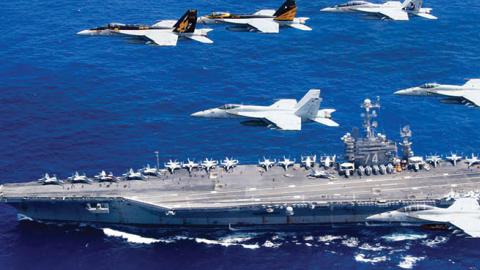More than a century ago, U.S. Navy captain Arthur Thayer Mahan argued in his seminal “The Influence of Seapower Upon History” that a maritime nation’s economic health and security depends on its navy and ability to control the seas. It was a straightforward assertion, but timely for a country poised to ride globalization’s first wave to economic dominance. Today, as we experience the digitized second wave of globalization, a virtual explosion of advocacy is resurrecting Mahan’s arguments. These new seapower evangelists, however, miss the point. The question is not whether to have a global navy, but what it should look like.
For Mahan’s America, caught between the Civil War and the First World War, whether to exert influence and trade on a global scale was a live question. In the 21st Century, this question is answered—the United States is a great power that depends on worldwide economic networks and relationships. And just as there is no realistic or equitable way to restore an isolated America that never really existed, there is no discernable movement today to make the U.S. Navy a coastal defense force. Seapower advocates should move on to the hard work of describing the future fleet’s design and operation, so the Congress and public know their money will be well-spent.
A Navy for what?
Today’s seapower renaissance emerges in part from concerns the Navy may lose to other priorities or military services in a zero-sum budget environment. These fears may be misplaced. The Biden Administration’s Interim National Security Strategy makes clear that the People’s Republic of China constitutes America’s most important strategic challenge, posing an economic and military threat to the United States and its allies as well as violating the human rights of its own people. Maritime forces, including the U.S. Coast Guard, have been central to thus far checking PRC aggression, channeling it into gray-zone operations that stay below the level of combat.
However, as Indo-Pacific commander ADM Phil Davidson noted last month, PRC military modernization will allow it to confidently pursue conventional conflict against the United States and its allies within this decade. No longer confined to the gray-zone, the People’s Liberation Army could attempt to force Taiwan to accept Beijing’s rule, take disputed islands from Japan, or solidify its control of the South China Sea.
U.S. naval services will remain essential for deterring PRC attacks on its neighbors; the question is what they are trying to deter and how. For example, if PRC leaders decide Taiwan’s independence creates an existential threat to their rule, they are likely to go “all in” and devote whatever forces are necessary to bring the island to heel. Optimizing the Navy to beat the PLA in the PRC’s backyard skews it toward large, multimission ships and aircraft designed to survive and fight in a highly contested environment. This fleet would be challenging to procure and unaffordable to sustain within anticipated budgets, which could result in a shrinking, unready fleet that ultimately undermines deterrence.
Instead of lowering risk for on a single high-intensity situation, Navy planning should seek to balance risk across a range of scenarios from an invasion of Taiwan to other situations such as an attempted seizure of smaller Taiwanese islands, a bombardment or blockade of Formosa, or a quarantine of Japan’s Southwest Islands. As evidenced by the Navy’s current readiness difficulties and inability to grow the fleet, protracted scenarios at sea could be more difficult for the Navy to address than a Taiwan invasion in which all Joint forces and capabilities can be brought to bear with permissive rules of engagement and ample supplemental funding.
A fleet for conflict and competition
Prolonged confrontations below the level of major power war would demand a Navy that can sustain an enhanced posture for months or years. However, the Navy’s difficulty maintaining even a modest increase in Middle East presence during the past several years suggests it will need more deployable platforms and lower operations and support costs than today’s fleet of exquisite multimission ships and aircraft. Notably, although the Navy is currently growing, many of its newer vessels are unable to deploy, such as Zumwalt destroyers, Littoral Combat Ships, and the USS Gerald Ford.
A Navy rebalanced from today’s monolithic high-end warships and aircraft towards a growing number of smaller, deployable, platforms and unmanned vehicles would present more proportional options for Combatant Commanders to counter gray-zone operations and address maritime security at vulnerable chokepoints. Using the command, control, and communications capabilities being developed under Project Convergence, distributed platforms could aggregate and mass effects for larger, more intense combat situations.
A rebalanced fleet would also be more adaptable compared to the current naval force, creating more uncertainty for opponents regarding the units to be employed and the tactics they will use. Using adaptability to attack an enemy’s orientation and decision-making could enhance the Navy’s effectiveness at deterring aggression by increasing the PRC’s uncertainty regarding the costs and ease of a military operation.
This is obviously only a sketch of what Navy planning should consider—but it represents the debate Navy advocates need to have instead of recycling century-old arguments that are not in contention. America knows it needs a Navy, but today’s seapower renaissance needs to produce a clear vision for the future fleet that is relevant for America’s 21st century challenges.
Read in Forbes

















